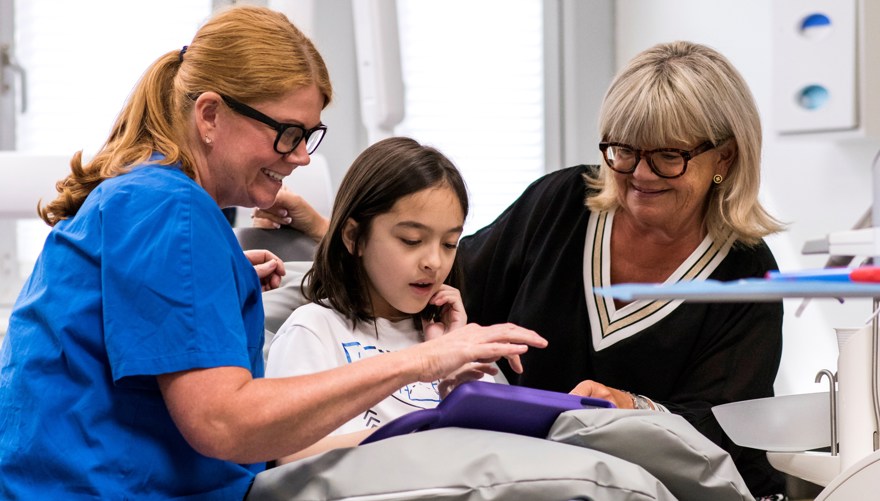Neurodevelopmental Disorders

This is the text from the oral care programme for people with Neurodevelopmental Disorders (NDD).
Over a period of many years, Mun-H-Center and specialist paediatric dentistry clinics have acquired knowledge and experience concerning the clinical treatment of patients with neurodevelopmental disorders (NDD). The majority of children and youths with NDD require an intensified approach to preventive dental care. Hypersensitivity to physical contact, odours, flavours and visual and auditory stimuli is common among NDD patients, as are cognitive impairments. These circumstances negatively impact both NDD patients’ ability to care for their oral health at home and their ability to participate during examinations and treatment at dental clinics.
Dental care staff who come in contact with children and youths with NDD need to apply specific techniques designed for treating special-needs patients. Establishing familiar, reassuring routines early on is important in helping NDD patients maintain good oral health. You can use this oral care programme for patients of all ages where necessary and in especially challenging clinical situations.
Background
NDD involves a difference in the way a person’s brain processes information. While anyone can forget appointments and have difficulty concentrating now and then, such difficulties only constitute a disorder when they are so severe that they seriously affect a person’s development and ability to function in the community.
People with NDD experience varying difficulties with the following:
- regulating their attention
- impulse control and activity level
- interpersonal interaction
- learning and memory
- expressing themselves orally and in writing
- fine and gross motor skills.
Dental care for patients with NDD
Need for preventive dental care
Children and youths with NDD should receive more frequent and intensified preventive dental care, since their hypersensitivity to physical contact, difficulties concentrating and cognitive impairments reduce their ability to care for their oral health. In most cases, NDD patients require a great deal of help from those around them.
Difficulties related to oral care
Children and youths with NDD commonly have difficulty tolerating dental and oral care. This emphasises the significance of tailored dental care for specific needs. They care team must be familiar with the patient’s diagnosis and be capable of providing them with a personalised acclimatisation to the dental care environment. Establishing familiar, reassuring routines early on helps NDD patients maintain good oral health and a trusting relationship with their dental practitioner.
Risk factors related to oral health
Children and youths with NDD run a higher risk of developing oral diseases, such as caries and periodontitis. This is due to a number of different factors. Some eat/drink frequently throughout the day and may prefer a monotonous diet. Some enjoy sweets, and sweets are sometimes also used as a form of reward. Many are also hypersensitive to physical contact and/or have a sensitive oral cavity, which can make them prone to nausea during treatment. Flavours, odours, light and sound also affect NDD patients to varying degrees. Combined, these factors often make performing oral care procedures on NDD patients particularly challenging. Another problem leading to an increased risk of poor oral health among NDD patients is the fact that many medications cause a dry mouth (xerostomia) as a side effect.
Guidance for carers & personal assistants
Carers and personal assistants should be involved in the
patient’s acclimatisation programme at the clinic or during a digital healthcare meeting and receive practical guidance from the dental team. Good cooperation between carers/personal assistants and practitioners will give NDD patients the best possible foundation for tolerating toothbrushing at home and procedures at the dental clinic.
Printed version
If you want more guidance about dental treatment and oral care for those with myotonic dystrophy, or if you have any comments on the content of the oral care programme, please contact us at mun-h-center@vgregion.se, +46 10 - 441 79 80
About the publication
- Authors: Maria Hall and Pia Dornèrus, dental nurses at Mun-H-Center.
- Layout, illustrations and photographs: Inga Svensson, Communicator, Mun-H-Center. Illustrations in the section Visual communication: KomHIT. Illustrations in the section Sensormimotor stimulation using Z-vibrator: Anders Nyberg
- Printed: 2019/05
Other languages
- Swedish - change language in the top menu to go to the Swedish website.

































